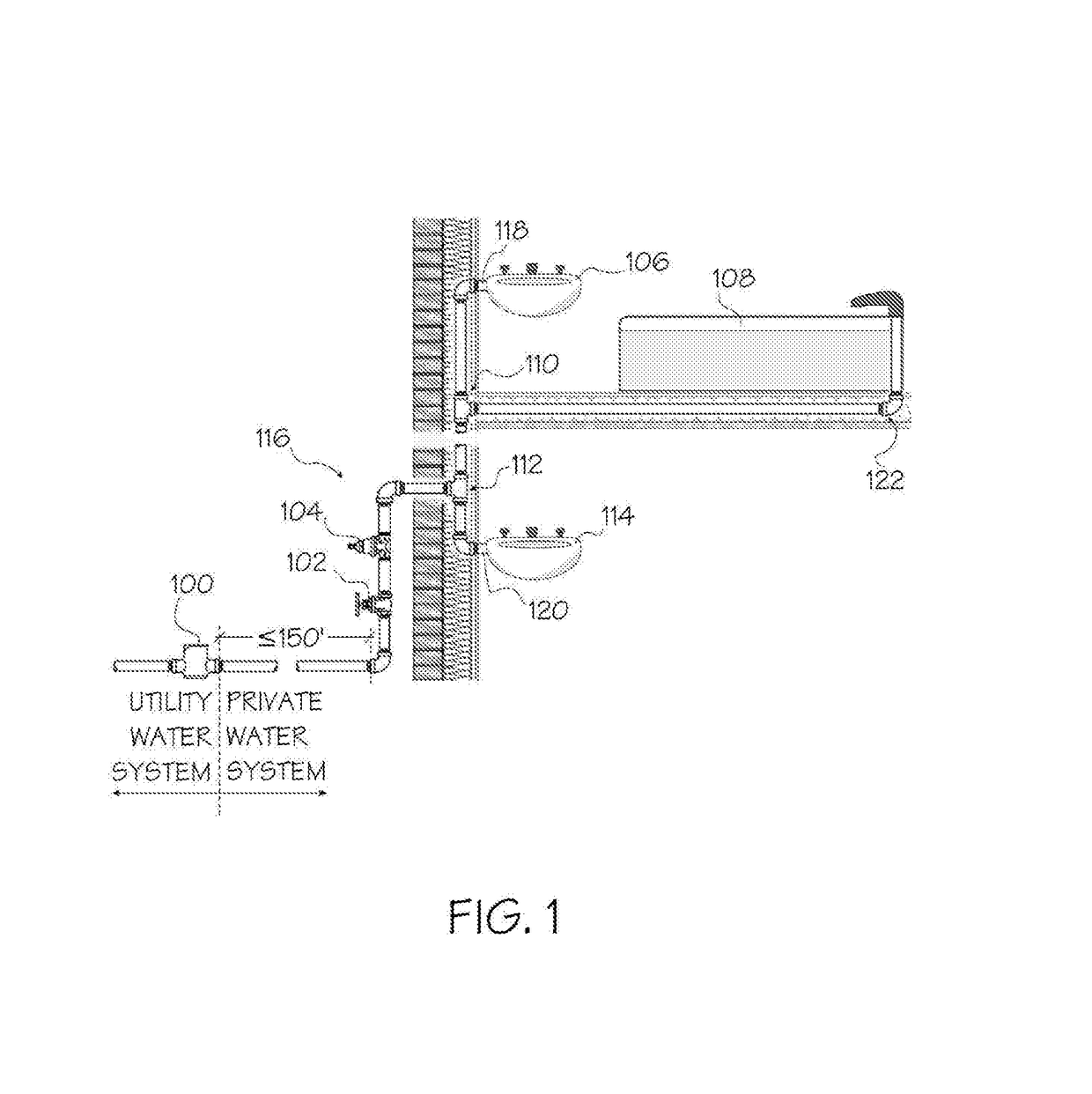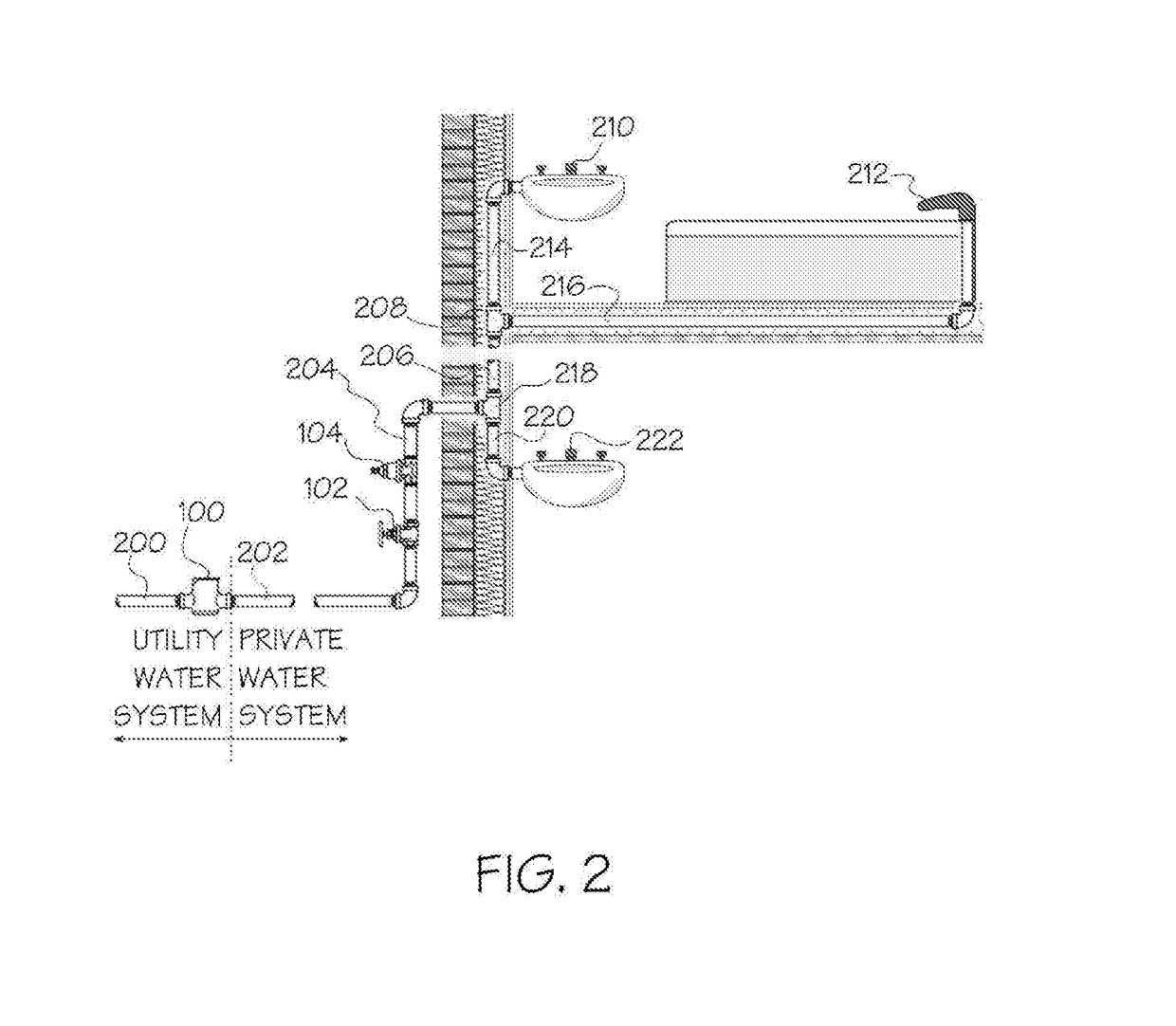Pressures lower than 55 psi may result in water fixtures operating poorly.
High
water pressure into a building site may damage internal plumbing pipes as well as cause water fixtures to malfunction; for this reason, the Plumbing Code requirement requires pressure regulators be installed on all water services greater than 80 psi.
High
system water pressure is also of a concern to the utility water operations as pipeline leaks or pipeline breaks will be more severe if the
system is operating at higher pressures.
Over time, pressure regulators can fail due to
corrosion or deposit buildup and thus requires that the
pressure regulator be checked periodically by a licensed plumber.
The amount of water flowing through the
system and the physical size of the path affect
friction loss.
However, since water fixtures at a building site can operate singly or concurrently and further since water fixtures can have varying flow demands (as in slightly open to fully open lavatory faucets) the pressure at different points in the water
distribution system at a building site will depend on the number of operating water fixtures at a given moment and the operating demand flow of each fixture at that moment making the pressure loss throughout the system and at each water fixture highly variable.
Additionally when repairs or maintenance is being done on the water infrastructure and water is shut off in certain areas to make repairs, the
water pressure at the meter will increase above the normal fluctuating range and further
impact the variability in
hydrostatic pressure delivered to the site.
High water pressure into a building site may damage internal plumbing pipes of the water
distribution system as well as cause water fixtures to malfunction causing water to leak at the building site.
In addition to high water pressure, water fixture
user error (e.g., user left a faucet open), faulty water fixtures (e.g., defective ice maker),
installation error (e.g., inadequate plumbing work), accidental damage to internal pipes or fixtures (e.g., drilling a screw into a
water pipe), or aging system components (e.g., corroded
pipe) are among other common causes of water leakages at building sites.
Water leaks on the inside of a building site can cause extensive damage to the building structure and to furnishings at the premises requiring significant reconstruction and replacement expense.
In addition, interior water leaks may lead to the growth of toxic mold and fungi requiring costly site remediation.
Outdoor water leaks can cause damage to the building site's foundation, the building structure itself, as well as damage the landscape
plant life.
In addition to the damage caused by water leaks, water leaks represent a significant waste of
water resources; water agencies estimate that for residential sites, up to 3% of all water consumed is attributable to water leaks.
Because of the expense and liability associated with water leaks, insurance companies have been increasingly placing limits on coverage for damage from water leaks and from toxic mold and fungi.
In addition, when
water damage has occurred, the property owner has a legal requirement, in the event of an intended property sale, to disclose the occurrence which may negatively affect the perceived value of the property to potential buyers.
While it is technically possible, the cost of such an extensive and precise
monitoring and control leak detection system is prohibitive for any wide scale adoption at residential and commercial environments.
In addition, in residential and most commercial environments the internal pipes and connections to water fixtures are typically not readily accessible for installation of pressure or flow sensors and of
control valves across branches of the water
distribution system as is the case in industrial environments.
In addition, to install the shut-off valve requires basic plumbing knowledge, fittings, and tools, as otherwise an improperly installed shut-off valve will create more opportunity for leaks than if the water detecting device were not installed.
In the case of an
AC power requirement, it is uncertain whether an AC outlet will be located near where the shut-off valve for the fixture would need to be installed (e.g., beneath a tub).
Another shortcoming of this method is the inability to access the plumbing
pipe line to a water fixture.
This method is also inappropriate for many types of water fixtures; for example, for a
shower the placement of the water detection device is not reasonable and placement of the shut-off valve would require major effort and expense to get access to the water fixture's water line typically located behind a water-tight wall.
Even in the case where all water fixtures were readily accessible without causing any obstruction by the installation of the device, and where there was a nearby power source at each water fixture to meet any power requirements, and where the water detecting
device placement would properly detect any water leaking from the fixture, a typical residential or commercial environment would require numerous devices being installed which would represent a significant expense in the cost of
purchasing the devices as well as the cost of properly installing the devices.
Perhaps one of the largest shortcomings of this method is that while it may shut-off water to an individual leaky water fixture, many water leaks do not originate at the fixtures themselves but originate from the connections to the water fixtures and from the internal pipes of the water distribution system.
These connections and internal pipes, as mentioned above, are not readily accessible and further, if they were, would require water detecting devices beneath and along the entire lengths of the internal
piping which is not practical nor economically feasible.
This method also has limited application in outdoor environments although a variant can be found in soil
moisture detection for
irrigation interrupt applications.
The thresholds for “
continuous flow” (e.g., maximum time of flow) or “excessive flow” (e.g., maximum flow rate) are either preset, set by the user, or conceivably could even be a learned behavior setting albeit at a significant increase in
unit cost of the device.
This method suffers from all of the same shortfalls as the “water detection beneath the water fixture” method previously described (with the exception of sensitivity to placement of the water detection device which is not applicable to this method) making this method equally impractical and equally economically unviable for effectively detecting and stopping water leaks at residential and commercial environments.
Since water fixtures can operate singly or concurrently, the maximum time of flow setting and the maximum flow rate setting are prone to causing this method to frequently interrupt the flow of water to the site since (a) fixtures operating sequentially but with overlap may have a demand flow for longer than the maximum time of flow, (b) fixtures operating concurrently may have a flow demand greater than the maximum flow rate setting, and (c) a single fixture can operate for longer than the maximum time of flow (e.g., a long
shower).
In addition, as in the case of the “flow detection at the fixture” method, if and when there is a leak with a rate flow below the maximum flow rate then water will continue to leak until the maximum time of flow is exceeded by which time the
water damage will have already taken place.
In summary, traditional
leak detection methods are too costly, too impractical, or too unreliable for effectively detecting water leaks, stopping water leaks, and preventing
water damage at residential and commercial sites to be acceptable for successful wide scale market adoption.
In addition, since the system requires fewer devices and components placed throughout the
stream network, this reduces the amount of error in the system, which includes
installation error,
user error, and error due to damage or aging of system components.
 Login to View More
Login to View More  Login to View More
Login to View More 


